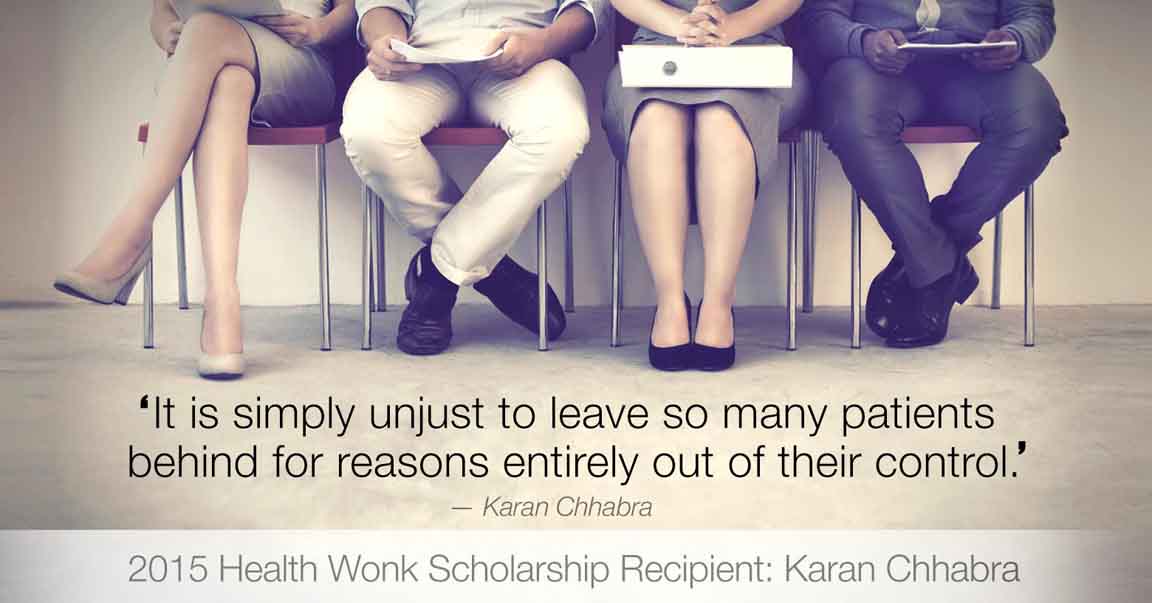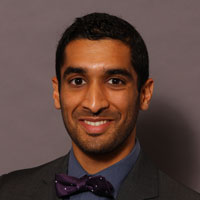
 The following guest post is from Karan Chhabra, a medical student at Rutgers Robert Wood Johnson Medical School, and winner of the $2,500 Gold Award in healthinsurance.org’s 2016 Health Wonk Scholarship competition.
The following guest post is from Karan Chhabra, a medical student at Rutgers Robert Wood Johnson Medical School, and winner of the $2,500 Gold Award in healthinsurance.org’s 2016 Health Wonk Scholarship competition.
Chhabra was selected from finalists with impressive backgrounds in healthcare. His career interests revolve around practicing academic surgery and working toward improving the value and quality of surgical care, particularly in the context of healthcare reform and delivery system change.
The scholarship committee was impressed not only by Chhabra’s educational achievements, but by his obvious passion for health policy discourse. Chhabra co-founded the blog Project Millennial and has contributed to Forbes.com, The Incidental Economist, The Health Care Blog, and other online outlets, as well as peer-reviewed journals such as JAMA and JAMA Surgery. The committee also recognized Chhabra’s work caring for uninsured patients and mentoring junior medical students at his school’s student-run Promise Clinic.
Chhabra’s scholarship essay offers his perspectives on the U.S. healthcare system – and his case for re-envisioning its patchwork-like safety net.
Congratulations to Karan Chhabra on his much-deserved scholarship – and to Sophia Park, an MBA candidate at the University of Chicago and recipient of the Health Wonk Scholarship $1,500 Silver Award.
Holes in the National Safety Net
Mr. A is a 40-year-old homeless, uninsured Hispanic male with a recent diagnosis of AIDS. He is currently undergoing treatment with Atripla (a branded three-drug combination antiretroviral pill), in addition to three prophylactic antibiotics. Though his follow-up has been hampered by lack of reliable telephone access, he has been receiving biweekly consultations with an infectious disease specialist, pharmacist, and dietician through the federal Ryan White program. His treatment has been guided by state-of-the-art HIV genotyping and laboratory monitoring, all available at no cost to him. His transportation to and from visits, as well as dental care, medications, and case management are also all covered at no charge.
Mr. B is a 50-year-old African-American male who recently tested positive for Hepatitis C. He is currently living in a drug/alcohol rehabilitation center after his recent release from prison. He is treated for routine primary care needs at our community health center, but there are no immediate plans to treat his chronic HCV. After three months in his rehabilitation program, he qualified for Medicaid, allowing his viral load to be checked. But given the few specialists accepting Medicaid and the prohibitive cost of antiviral medication, he has not been treated at all for his HCV.
The patchwork
For as long as American medicine has cost real money, we have made an effort to care for the impoverished. Charity hospitals and clinics first took this role, followed by public hospitals and eventually Medicare and Medicaid.1 But these systems inevitably left some out of their graces. Over half a century, we have arrived at a system that provides world-class services to some, and nearly nothing to others. In my personal experience working within the safety net, at a federally qualified health center in New Jersey, I have witnessed these contradictions firsthand – Mr. A and Mr. B’s true stories are unfortunately common examples. The patchy history of our safety net parallels that of our whole healthcare system, including our most recent attempts at health reform. Any remedy for these inequities ought to be informed by this history and its failures.
This story in health policy begins at the turn of the 20th century, when developed countries around Europe were building nationwide health insurance programs. United States reformers made several such attempts as well, all thwarted by more urgent political priorities, such as unemployment during the Great Depression.2 As early as the 1930s, though, the American Medical Association’s lobbying propagated fears of “socialized medicine” and blocked efforts like President Truman’s proposal to create a universal insurance system through the Wagner-Murray-Dingell Bill. This policy vacuum allowed the prevailing insurance system to take root: primarily employer-sponsored health insurance, supplemented with some federal support through the Kerr-Mills Act for healthcare providers and states funding charity care.2,3 When Medicaid legislation was created, it extended the Kerr-Mills system of federal aid to states instead of building a comprehensive solution such as Truman’s Wagner-Murray-Dingell bill. Thus our commitment to a fragmented safety net was made well before the passage of Medicare and Medicaid, and was influenced by political realities much like today’s.2,3
ACA’s gains – and what’s still missing
Over the next few decades, most health reforms have built around this structure. President Obama’s landmark Affordable Care Act (ACA), whose primary goal was to expand insurance coverage, nonetheless did the same: it expanded Medicaid to a broader population, and subsidized private insurance for those still not eligible. It also enacted numerous protections for patients, including out-of-pocket maximums, under-26 coverage, and much more – but it left the overall structure of the safety net intact, and 32 million still uninsured.4
Nine million newly insured Americans have finally been “caught” by the safety net. But by working at Zufall Health Center (ZHC), a federally qualified health center in Morristown, NJ, I became intimately familiar with what’s available and what’s still missing for the 32 million who continue to fall through the gaps. Our FQHC cared for every patient regardless of ability to pay, including a large undocumented migrant population not even included in our counts of the uninsured. But we also saw middle-aged executives between jobs, yuppies looking for convenient hours, elderly relatives of South Asian expats, children who’d fled Mexico without their parents – and patients of many stripes in between.
Before working at ZHC, I thought all it took to care for the underserved was a primary care doctor with a mission. I quickly found I was wrong. External grant funding, precarious as it was, made it possible to accept sliding-scale payments. Arrangements with a local laboratory and pharmacy allowed us to provide basic testing and medications affordably. An informal network of specialists provided their services for free or a discounted rate: a colorectal surgeon for screening colonoscopies, a podiatrist and ophthalmologist for diabetics, an infectious disease specialist seeing patients like Mr. A. Every test and treatment we considered was influenced by the patient’s background: for instance, we might ask a reliable patient to go to the pharmacy to pick up a discounted prescription, but we would make every effort to care for those in shakier circumstances with the drugs available in our own dispensary.
It takes a medical village
It turns out that one well-supported medical home can address many primary care needs. But it takes a medical village to care for a population adequately. And for our population, some members of the village were more available than others. For instance, we could send patients for free screening and treatment for colorectal, breast, cervical, and prostate cancer through a state program. For uninsured patients with HIV/AIDS like Mr. A, the federal Ryan White program provides world-class, interdisciplinary treatment and care coordination. But despite having Medicaid, Mr. B could not even get a specialist consultation for his HCV. End-stage renal disease (ESRD) in a legal resident guarantees automatic Medicare coverage (even under age 65), but end-stage lung, liver, and heart disease do not. The local hospital could provide some imaging under charity care for the uninsured but would not accept two of the state’s four Medicaid plans.
The lines along which the safety net is sewn are often arbitrary but never inconsequential. Demographics wield undue force; in many states, childless adults cannot get Medicaid regardless of income. (Though the ACA attempted to standardize Medicaid eligibility nationwide, the Supreme Court in NFIB v. Sebelius struck this provision down, leaving 3 million Americans in a “coverage gap” between Medicaid and subsidized insurance.4,5)
Next for the uninsured comes the question of disease. The aforementioned cancers, HIV, and ESRD are provided for, but fractures, Hepatitis C, and chronic lung disease are not. Finally, who is actually delivering their care? Community health centers like ours have grant funding to offset uncompensated care; hospitals are mandated to stabilize whoever walks through their doors; a specialist in private practice, however, can choose whom he or she sees. In some areas, an academic physician practice provides specialty care to the poor-but every region is not so lucky.
Millions falling through the safety net
So what happens to the rest of the indigent sick, the millions of Americans who fall between the patches of the safety net? Where are the coverage options for indigent childless adults, for the undocumented, and for those not poor enough for their state to consider them Medicaid-worthy? When zero of our area’s 57 orthopedic surgeons would see an uninsured patient, and few would even take Medicaid, where can they go for disabling chronic joint disease? Where is the state program to screen for the #1 cancer killer in the U.S.: lung cancer?6 Where is the federal program for patients with Hepatitis C like Mr. B?
I’ve come to believe these are largely the wrong questions. The problem is not that there aren’t enough programs to cover each disease suffered by the uninsured. The problem is the patchwork approach, which may provide excellent care to those who’ve won the “disease lottery,” but abandons the rest. As a nation, we seem to have accepted the mosaic system when we decided against a national, universal system of health coverage. The approach we chose left millions behind. And the safety net we established is better than none at all – to be sure – but it is one that developed organically, out of local resources and political will, rather than a concerted effort to care for the poor.7
Every patch in the safety net is borne of good intentions. The Ryan White Care Act was passed in the name of a high school student, infected with HIV by a transfusion, who helped break the disease’s stereotype as one of homosexuals.8 Advocacy groups have drawn considerable awareness and funding toward certain cancers, but perhaps at the expense of other vicious cancers and illnesses that draw less sympathy. Community clinics and public hospitals are critical pieces of infrastructure, but they can only do so much within their four walls, and their delicate finances place them in constant jeopardy.
The moral case for re-envisioning our safety net
The moral case for re-envisioning our safety net should be obvious: it is simply unjust to leave so many patients behind for reasons entirely out of their control. The numbers are embarrassing, and witnessing these patients’ pain and fear is heartbreaking. In addition to being morally untenable, though, the current system is epidemiologically misguided. By allocating resources based on political rather than public health considerations, we systematically neglect widespread and devastating illnesses that we often know how to treat effectively. Lung cancer, for instance, is still thought of as a disease of smokers (even though as many as one-fifth of new cases appear to occur in patients who’ve never smoked9): is this why our state won’t pay to screen the uninsured, despite the latest recommendations?10 Though Hepatitis C is typically a chronic, smoldering illness, it currently kills more Americans than HIV, and its newest treatments are often curative.11 Chronic renal failure is covered; however, chronic lung disease is the third-leading cause of death in America, yet the inhalers used to keep patients alive and out of the hospital are unavailable as generics and prohibitively expensive to the uninsured.12,13 The theme is simple: a framework assembled without a rational plan cares for patients irrationally.
But no one today is entirely to blame for this. The state of our safety net is the byproduct of decades of history, and those trying to make it stronger should be praised for their dedication to a difficult calling. We should also, though, learn from the mistakes of the past and the contradictions of the present. In today’s United States, basic healthcare should be everyone’s right, and insurance coverage is the first (though not the only) step toward this goal. Disease – and demographic-specific adjuncts to Medicaid – help many patients in the short run, but in the long run they perpetuate a system that inherently leaves out many more. With the passage of the ACA, the safety net grew wider and stronger, but it still contains large holes that have not been addressed. When we next attempt to reform healthcare, years or decades from now, we will need to decide again as a nation whether we want to patch these holes or weave a new safety net entirely. I hope we choose a system that is as comprehensive, evidence-based, and patient-centered as the medical care it aims to provide.
Works cited
1. Starr P. The Social Transformation of American Medicine. Basic Books; 1982.
2. Starr P. The Health Care Legacy of the Great Society. In: Glickman NJ, Lynn LE, Wilson RH, eds. LBJ’s Neglected Legacy: The Policy and Management Legacies of the Johnson Years: University of Texas Press; 2015.
3. National Health Insurance – A Brief History of Reform Efforts in the US. Washington DC: Kaiser Family Foundation; 2009.
4. Majerol M, Newkirk V, Garfield R. The Uninsured: A Primer. Washington, DC: The Kaiser Commission on Medicaid and the Uninsured; 2015.
5. Garfield R, Damico A. The Coverage Gap: Uninsured Poor Adults in States that Do Not Expand Medicaid – An Update. Washington, DC: The Kaiser Commission on Medicaid and the Uninsured; October 2015.
6. Estimated Deaths for the FourMajor Cancers by Sex and Age Group, 2015. American Cancer Society Surveillance Research 2015.
7. Waitzkin H. Commentary – The History and Contradictions of the Health Care Safety Net. Health Services Research. 2005; 40(3):941-952.
8. The Ryan White HIV/AIDS Program – A Living History.
9. Helwick C. Lung Cancer Rates Doubling Among Nonsmokers. The ASCO Post. Accessed December 31, 2015.
10. Moyer V. Screening for Lung Cancer: U.S. Preventive Services Task Force Recommendation Statement. Annals of Internal Medicine. 2014; 160(5):330-338.
11. Ly KN, Xing J, Klevens RM, Jiles RB, Ward JW, Holmberg SD. The increasing burden of mortality from viral hepatitis in the United States between 1999 and 2007. Annals of internal medicine. 2012; 156(4):271-278.
12. FastStats – Leading Causes of Death. 2015.
13. Rosenthal E. The Soaring Cost of a Simple Breath. The New York Times. October 13, 2013.








